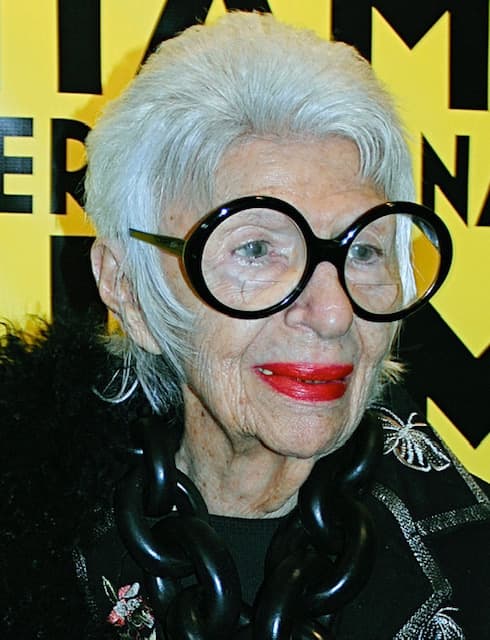
On March 8, 2015, Iris Apfel appeared at O Cinema Miami Beach to present “Iris,” Albert Maysles’ documentary about her. https://www.flickr.com/photos/55155430@N03/16733360409/
She’s been the subject of an exhibit at The Metropolitan Museum of Art Costume Institute and a documentary film, the inspiration for a Barbie and a character in “The Incredibles” film series.
Designer Iris Apfel, who died March 1 at her home in Palm Beach at age 102, was, to borrow the name of her jewelry collection and the Costume Institute retrospective, a Rara Avis (rare bird) indeed – a maximalist among minimalists, an individual in a world a conformity, a woman of style where others sought to be merely fashionable.
“Why would you want to look like everyone else when there’s such a big choice of things today?” she told Harper’s Bazaar in 2018. “It’s hard to give blanket advice, but I just think that if everybody tries to be as self-respecting and interesting as they can, it would be a better world. Use your head and think about other people and look in a mirror once in a while.”
The mirror came naturally to the native New Yorker, whose family owned a glass and mirror business and whose mother had a fashion boutique. As a youth, Apfel scoured antique shops and drew style compliments from a Brooklyn department store. Even during the Depression, she and her crafts-minded family stayed stylish on a budget. Apfel studied art history at New York University and art at the University of Wisconsin, then honed her eye working for Women’s Wear Daily, interior designer Elinor Johnson and illustrator Robert Goodman.
But it was her longtime professional and personal partnership with Carl Apfel that propelled her onto the world stage. In 1950, they started the textile business Old World Weavers, which reproduced 17th through 19th century fabrics. Among their clients – nine U.S. presidents, from Harry Truman to Ronald Reagan inclusive and Bill Clinton.
Sourcing fabrics from around the world, Apfel also began buying artisanal clothes in bright colors and bold textures and patterns that she would pair with her statement jewelry pieces and wear at parties. Add her oversize glasses, red lipstick and, as time went on, shock of white hair, and you had the makings of a global style icon.
As the urban legend goes, an exhibit at the Costume Institute fell through, and “Rara Avis: Selections From the Iris Apfel Collection” soared in 2005, marking the Costume Institute’s first show about someone who was not a fashion designer. What followed was a media blitz – a touring exhibit, two documentaries (“Iris” and “If You’re Not in the Obit, Eat Breakfast”), a book (“Iris Apfel, Accidental Icon”), a Barbie that was not for sale, plus two “Styled by Iris Apfel” Barbies that were, and a modeling contract. (The Museum of Lifestyle & Fashion History in Boynton Beach, Florida, is designing a building with a gallery to house Apfel’s clothes, accessories,and furnishings.)
Apfel did it all, and she did it her way. At a time when everyone began discarding everything Marie Kondo style, Apfel layered her looks and her dwellings. She was the living embodiment of the Mae West saying: “Too much of a good thing can be wonderful.”
Tags: Iris Apfel, The Metropolitan Museum of Art, Costume Institute, Palm Beach, New York University, Harper’s Bazaar, Mae West, Carl Apfel, Old World Weavers, Harry Truman, Ronald Reagan, Bill Clinton, Barbie, “Rara Avis (Rare Bird): The Irreverent Irish Apfel,” “If You’re Not in the Obit, Eat Breakfast,” Elinor Johnson, Robert Goodman, University of Wisconsin, Women’s Wear Daily, Albert Maysles, O Cinema Miami Beach, Miami Film Festival,
